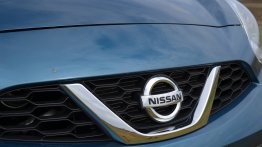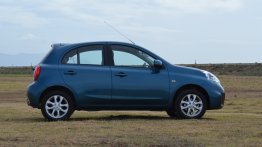The next generation Nissan Micra that is coming to India next year, is gaining rapid traction in international media. Nissan has issued a press release with details and comments on the new V-Platform, which forms the base for future models, starting with the Micra hatchback. The Japanese manufacturer says if the competitor is not up to the mark, the Nissan Micra will be the best small car in the world.
Toyota, Honda and Mitsubishi need to take this seriously.
We can't verify that claim till March 2010 when the car will hit the floor of the motor show floor of Geneva for the first time.
Press Release
| PRESS RELEASE: INNOVATIVE GLOBAL COMPACT CAR SETS NEW STANDARD Production to commence in three different countries employing all-new V-Platform across next generation compact car lineup As an integral part of a global breakthrough project, Nissan Motor Company announced the imminent introduction of an innovative V-Platform and an all-new global compact car that will employ this technology. Breaking with traditions that focused on launching production in established markets like the U.S., Europe and Japan, Nissan has instigated revolutionary measures to start production of a completely new model at overseas manufacturing sites such as India, China and Thailand. To achieve this goal, an all-new production process has been incorporated to maintain Nissan's 'no compromise' high quality levels, great packaging and competitive pricing. This project was borne out of three critical factors: growing customer needs for compact cars in emerging markets, the fact that Nissan has not had a strong presence in this segment which occupies more than 20% of the world market, and the opportunity that such a global strategy gives Nissan to utilize both global reach and technical capabilities. To co-ordinate this unprecedented development effort, that will see the V-Platform incorporated into at least two other models over the next three years, Nissan put together a unique team of specialists boasting industry-leading experience and know-how in production, localization and product planning. Joining project leader Vincent Cobee is former chief engineer Noritaka Tsuru who has developed vehicles globally for over two decades. Also instrumental in the development process was Keno Kato, compact car product planning specialist. Bringing the world's best to the table Called "Smart Engineering," Nissan's new engineering initiative was fine-tuned to meet the requirements of the new V-Platform, models and production method, while keeping costs down. "We are also aiming to generate new values with smart new ideas," says Vincent Cobee, "For me, this was like confronting the very future of Nissan. We made the decision to build a series of cars in countries that transcended all markets, and in so doing, will be a superb combination of functionality, modernity, good design and handling, roominess and status satisfaction. The fact that we will not launch these cars from Japan, Europe or the U.S. will have absolutely no impact on their quality. Our proven, global high quality production system has guaranteed world-class standards." "My team devised a clever way to develop a competitive volume seller that will not be built in existing core markets. Not an easy combination," adds Noritaka Tsuru. Nissan had to get production costs down, while optimizing localization efforts and local supplier networks. "We achieved this while responding to the discerning needs of each market and without compromising quality," adds Keno Kato. "For example, even in small cars, customers want features like latest audio system and air-conditioning. The emerging markets like China and India want all of these features now too, but at the same time, they want their cars to be as competitively priced as possible. The bottom line is that we end up with a great car by satisfying the needs and difficult requests of different customers, in both matured and emerging markets." The development directive handed to the production team encapsulated Kato's findings and much, much more. This directive delivered to Cobee and Tsuru by senior management was clear but extremely challenging at the same time. "We were told from the outset," recalls Tsuru, "that we would be working on not just a new car project, but instead a 'breakthrough.' The directive also stipulated that we'd be working on a series of cars, not just one model, and that we were expected to create a whole new method in the way we develop cars. And this new line-up of compact vehicles had to generate huge volume as well as profits." Nothing of this magnitude had ever been attempted before. Building a series of models on the same platform at three overseas production sites for sale in over 160 countries was a huge undertaking, one that required a redefining of product planning and production methods. Meeting all the goals, and then some! Nissan invited local engineers from the three main sites of production in India, Thailand and China to the Global Production Engineering Center (GPEC) at Nissan Zama Operations Center [just south of Tokyo] to learn the Nissan Production Way (NPW). Then the company sent Japanese support staff with their overseas counterparts back to their countries to assist with start-up procedures at all three plants. In that way, Nissan maintained its high quality levels while at the same time optimizing local production methods with a localization rate of over 80%, a critical factor to avoid unnecessary costs such as logistics and import duties. As the project was deployed in three emerging countries at the same time, local production staff and suppliers instructed in the NPW are supporting each other by exchanging information and working together on quality optimization. All international staff are also fully aware of what this "V-Platform breakthrough" means for Nissan. To simply carry over the current platform would not have achieved the goals set in the directive. "By building a dedicated new platform for the global market, we were able to improve fuel economy and CO2 emissions and also fit the cars to a high specification while building them down to an affordable price," stresses Cobee. He adds that to build a series of vehicles in this way also creates solid investment efficiency across the whole V-Platform lineup of vehicles while allowing the company to build a car with good performance, sharp looks and class-leading quality. Thinking outside the box Tsuru's job was not just to achieve this affordable, high quality combination, he had to motivate his team to work under a very tight production cost structure. Telling his design team to forget the way they had worked up until now was hard, and they struggled. He says that working to reduce weight and costs is not normally a fun job, and his team's initial responses reflected the hardships of the new way. "But when you strive to reduce weight and costs significantly by thinking cleverly outside the box, and then come up with breakthrough ideas to realize a product that is very attractive, then it all becomes worthwhile," he smiles. Tsuru says that the team's motivation increased measurably as the project progressed. The fact that Nissan will produce these cars on the V-Platform in emerging countries is strategic and important. "We do not discriminate against emerging markets. We invest in volume-driven, multiple market-focused models that use our new platform," says Cobee. Nissan has arrived at a stage where it is willing to build a brand new compact car and embark on major, massive global investment without making something that is over-specification. Cobee believes that 1,000,000 vehicles per year, based on the V-Platform at the project's full ramp-up, is well within the company's reach. "And why not?" says Tsuru, "I'm sure customers will love the car. They will be attracted by its fun, stress-free city driving and low cost of ownership." With cars employing small bore, clean, fuel efficient petrol and diesel engines, customers will be able to choose from a range of transmissions. "They perform superbly around town but also display great stability and poise on highways, look great, have plenty of room and offer a status level not seen on compact cars of this size before," reinforces Cobee. With the world premiere of Nissan's new global compact car slated for a Geneva Motor Show reveal in early March 2010, and other models based on the same platform to follow soon after, Nissan's new V-Platform based vehicles will set a new global standard. Stressing the company's resolve, Tsuru threw down the gauntlet to the industry. "I am sure that unless our competitors do a greater job, our new V-Platform product will be the best compact car in the world." |















